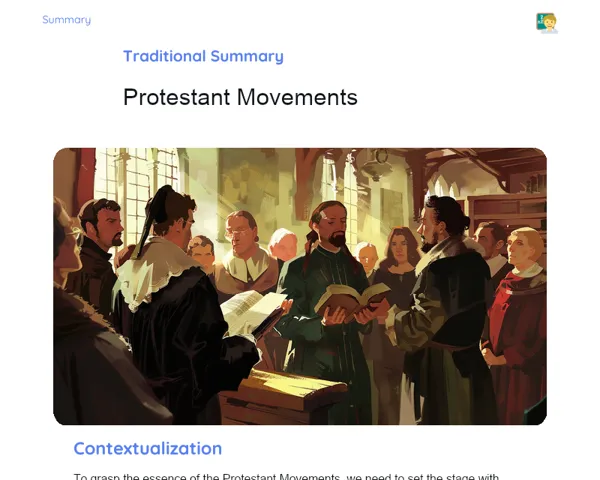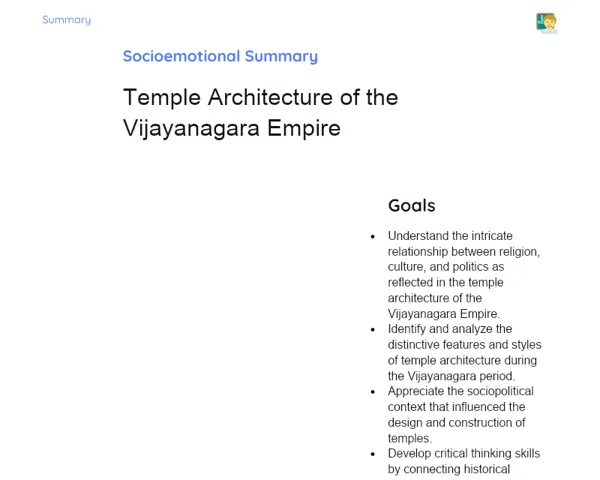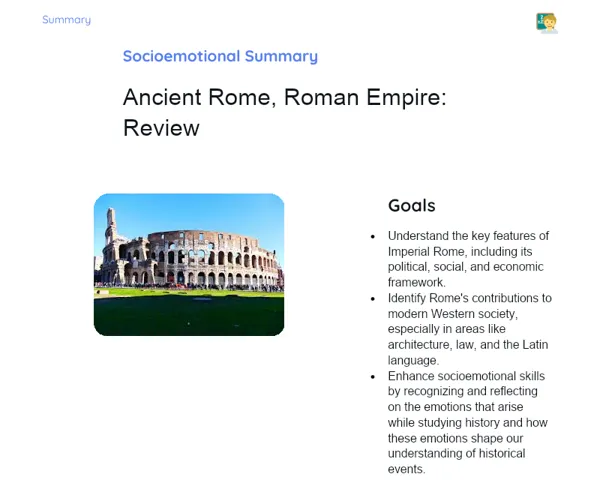Summary Tradisional | Fall of the Western Roman Empire, Late Antiquity: Review
Contextualization
The Roman Empire was one of the largest and most influential civilizations of the ancient world, stretching across Europe, Asia, and Africa. At its peak, Rome was a bustling city with over a million residents, quite an achievement for that era. Known for its formidable military, technological innovations, and extensive infrastructure like roads and aqueducts, Rome facilitated trade and communication. Yet, over time, the empire encountered numerous challenges that led to its decline. These issues included economic hardships, political corruption, civil conflicts, and relentless barbarian invasions. In 395 AD, the empire was split into the Western Roman Empire and the Eastern Roman Empire to better manage its vast territories. This division, however, ultimately rendered the Western Empire even weaker, compounding its pre-existing problems. The fall of the Western Roman Empire in 476 AD, marked by the ousting of the last emperor, Romulus Augustulus, by Odoacer, signified the end of an epoch and heralded the Middle Ages—a period noted for feudalism and the rise of Christianity.
To Remember!
Internal Factors Behind the Fall of the Roman Empire
Internal issues were pivotal in the downfall of the Western Roman Empire. Key among these were economic challenges, such as inflation, soaring taxes, and a heavy reliance on slaves. These financial strains eroded the empire's economic stability, making it tough to maintain a capable army and undertake infrastructure projects. Political corruption was another major internal issue. Many of the Roman leaders were self-serving and ineffective, leading to chaotic administration and eroding public faith in the government. This corruption even allowed incompetent leaders to rise to power, who lacked the abilities needed to tackle the empire's many challenges. Civil wars added to the instability, as continuous internal strife drained resources that could have defended against external threats. The ineffectiveness of certain emperors, who failed to demonstrate adequate leadership or organizational skills, further accelerated the empire's decline.
-
Economic Challenges: Inflation, rising taxes, and over-reliance on slave labor.
-
Political Corruption: Inefficient and corrupt rulers.
-
Civil Wars: Ongoing internal conflicts destablized the empire.
-
Emperor Ineptitude: Insufficient leadership and administrative acumen.
External Factors Contributing to the Fall of the Roman Empire
External challenges also played a crucial part in the decline of the Western Roman Empire. Invasions by barbarian tribes were among the foremost threats faced by Rome. Groups such as the Visigoths, Vandals, and Huns launched destructive raids into Roman lands, pillaging cities and causing significant destruction. The constant fear of these invasions required ongoing defense efforts that drained resources and further weakened the empire. Integrating barbarian warriors into the Roman army, a strategy employed to bolster military ranks, resulted in divided loyalties and potential betrayals, exacerbating internal instability. These invasions not only caused rampant destruction in Roman cities but also diminished the morale of citizens and soldiers alike, paving the way for the empire's collapse. Rome's failure to fend off these invasions highlighted its vulnerability and hastened its unraveling.
-
Barbarian Invasions: Tribes like the Visigoths, Vandals, and Huns.
-
Persistent Threat: Ongoing need for defense draining resources.
-
Barbarian Integration in the Army: Issues with loyalty and betrayals.
The Division of the Roman Empire
The 395 AD partition of the Roman Empire was aimed at improving management of its vast territories. This division created the Western Roman Empire and the Eastern Roman Empire, with the belief that focused regional governance could better tackle localized challenges. However, this split had far-reaching effects. While the Eastern Roman Empire, which became known as the Byzantine Empire, thrived for another thousand years, the Western Roman Empire succumbed to invasions and internal turmoil. The separation diminished the unity of the empire, complicating its ability to coordinate defense against external threats and manage internal crises effectively. Disparities became evident between the two halves, with the East, led from Constantinople, being more affluent and less affected by invasions, while the West, with Rome as its capital, faced mounting challenges.
-
Division in 395 AD: Aimed at better managing territories.
-
Consequences: Increased vulnerability of the Western Empire.
-
Disparities: Economic and cultural differences between East and West.
The Dawn of the Middle Ages and the Rise of Christianity
The fall of the Western Roman Empire in 476 AD marked the advent of the Middle Ages, a time defined by a decentralization of power and the rise of feudalism. Following the empire's collapse, Western Europe saw political fragmentation as authority dispersed among feudal lords governing small areas. Feudalism became the prevalent social and economic structure, with land serving as the principal source of wealth and power. Society was organized through vassal relationships, where serfs cultivated the land owned by lords in exchange for protection and basic sustenance. This system replaced the centralized governance of the Roman Empire, shaping medieval society profoundly. Concurrently, Christianity experienced substantial growth during Late Antiquity and the Middle Ages. The Catholic Church emerged as a powerful institution not only in the religious realm but also in politics and culture. The conversion of Emperor Constantine and the Edict of Milan in 313 AD, which legalized Christianity, marked significant milestones in this religious expansion. The Church provided a framework of authority and continuity, filling the void left by the empire’s collapse.
-
Dawn of the Middle Ages: Decentralized power and rise of feudalism.
-
Feudalism: Socioeconomic system based on vassal relationships.
-
Boom in Christianity: Influence of the Catholic Church in the socio-cultural realm.
-
Edict of Milan (313 AD): Legalization of Christianity and bolstering of Church influence.
Key Terms
-
Fall of the Western Roman Empire: Decline and eventual deposition of the last emperor in 476 AD.
-
Late Antiquity: Transition phase between Classical Antiquity and the Middle Ages, roughly spanning the 3rd to 6th century.
-
Internal Factors: Factors like economic problems and political corruption that led to the empire's decline.
-
External Factors: Elements like barbarian invasions contributing to the empire's fall.
-
Division of the Empire: Separation of the Roman Empire into Western and Eastern parts in 395 AD.
-
Beginning of the Middle Ages: Period following the Western Roman Empire's collapse, marked by feudalism.
-
Growth of Christianity: Expansion of Christian teachings and the influence of the Catholic Church.
-
Economic Crises: Financial difficulties impacting the empire, including inflation and increasing taxes.
-
Political Corruption: Inept rulers contributing to disorganization within the empire.
-
Civil Wars: Internal strife that weakened the empire's unity.
-
Barbarian Invasions: Attacks from tribes like the Visigoths, Vandals, and Huns.
-
Eastern Roman Empire: Eastern segment that persisted as the Byzantine Empire.
-
Feudalism: Medieval system based on feudal hierarchy.
-
Catholic Church: Religious body that gained authority during the Middle Ages.
-
Romulus Augustulus: Final emperor of the Western Roman Empire.
-
Odoacer: Barbarian leader responsible for Romulus Augustulus's deposition.
-
Visigoths: Barbarian tribe that besieged and sacked Rome in 410 AD.
-
Vandals: Barbarian group that invaded Rome in 455 AD.
-
Huns: Nomadic group led by Attila, attacking Roman territories.
Important Conclusions
The fall of the Western Roman Empire was a multifaceted event, driven by a mix of internal and external factors. Domestically, economic crises, political corruption, and civil unrest undermined the empire's structure. Externally, barbarian invasions from tribes like the Visigoths, Vandals, and Huns expedited its disintegration. The division of the empire in 395 AD further compromised the Western region, ultimately leading to the ousting of the last emperor, Romulus Augustulus, in 476 AD. This event ushered in the Middle Ages, an era marked by feudal governance and political fragmentation. It also saw the notable rise of Christianity, with the Catholic Church becoming a significant player in both the political and cultural arenas. The transition from ancient Rome to the medieval age was intricate, shaping European society for centuries to come. Gaining insights into this historical decline is vital for understanding the roots of modern Europe and Western civilization. The legacies of this period, from the Romans’ road networks to Christianity's ongoing cultural and spiritual significance, are evident in today's world, offering valuable lessons on the challenges faced by complex societies and the strategies to navigate them.
Study Tips
-
Review both internal and external factors leading to the fall of the Western Roman Empire. Take notes and create a visual mind map for clarity.
-
Delve into primary and secondary sources from this period, such as historical writings and contemporary analyses, to enrich your understanding.
-
Engage with colleagues or join study groups to discuss these topics and share insights, which can enhance your learning experience.



